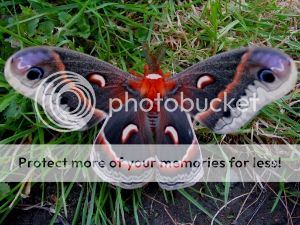Moth Eyes Help Create Efficient Solar Cells

The modern mindset has a tendency to believe that only people in the past looked to animals to understand the world. Yet, much of our modern technology continues to look to nature for inspiration and answers. Therefore, when people as a collective take an apathetic attitude about the concerns over wildlife extinction, we not only senselessly destroy a species, but our own chances for continued evolution.
Without question, the 21st century has been about the struggle for clean, efficient, reusable energy resources. The staggering cost of fossil fuel use is simply unsustainable to the family wallet, global economy, and the environment, irrespective to what any oil mecca has to say. Thankfully, solar fields are becoming more commonplace. While they do provide reliable, clean energy, the panels typically have a low efficiency rating. The root cause of this deficit is light reflection between horizontal films, which allows for thin-film interference, or light loss, before it can be harnessed and turned into energy. In an attempt to solve this problem, researchers at North Carolina State University wisely turned to biomimicry for answers.
In looking to nature for the answers, they discovered the solution to the problem was in the natural surface structure of moth eyes, which are so non-reflective they need only an infinitesimal source of light for clear vision in the dark. Because moth eyes evolved to a state where they no longer reflect light, researchers were able to mimic the concept and develop a nanostructure that significantly minimizes issues associated with thin-film interference. These nanostructures are shaped like tiny cones, much like that found in a moth's eye. The concept involves a solid bottom layer, a thin top layer, and a middle layer lined with cones that slightly intrudes into the surface layer, thereby absorbing more rays from a vertical advantage, allowing it to flow directly downward to the processing panel. Comparative studies between the nanostructure and the thin-film models showed that the nanotechnology, inspired by moths, reflected back 100 times less light, thereby making the design exceptionally efficient.
This is Deb Duxbury, for Animal Life, reminding you to please spay or neuter your pet.
Without question, the 21st century has been about the struggle for clean, efficient, reusable energy resources. The staggering cost of fossil fuel use is simply unsustainable to the family wallet, global economy, and the environment, irrespective to what any oil mecca has to say. Thankfully, solar fields are becoming more commonplace. While they do provide reliable, clean energy, the panels typically have a low efficiency rating. The root cause of this deficit is light reflection between horizontal films, which allows for thin-film interference, or light loss, before it can be harnessed and turned into energy. In an attempt to solve this problem, researchers at North Carolina State University wisely turned to biomimicry for answers.
In looking to nature for the answers, they discovered the solution to the problem was in the natural surface structure of moth eyes, which are so non-reflective they need only an infinitesimal source of light for clear vision in the dark. Because moth eyes evolved to a state where they no longer reflect light, researchers were able to mimic the concept and develop a nanostructure that significantly minimizes issues associated with thin-film interference. These nanostructures are shaped like tiny cones, much like that found in a moth's eye. The concept involves a solid bottom layer, a thin top layer, and a middle layer lined with cones that slightly intrudes into the surface layer, thereby absorbing more rays from a vertical advantage, allowing it to flow directly downward to the processing panel. Comparative studies between the nanostructure and the thin-film models showed that the nanotechnology, inspired by moths, reflected back 100 times less light, thereby making the design exceptionally efficient.
This is Deb Duxbury, for Animal Life, reminding you to please spay or neuter your pet.
You Should Also Read:
Are You Scared of Arachnids? Meet the Lifesaver!
Health Benefits of Bee Pollen
How Animals Help Troubled Children

Related Articles
Editor's Picks Articles
Top Ten Articles
Previous Features
Site Map
Follow @WildlifeWelfare
Tweet
Content copyright © 2023 by Deb Duxbury. All rights reserved.
This content was written by Deb Duxbury. If you wish to use this content in any manner, you need written permission. Contact Deb Duxbury for details.







